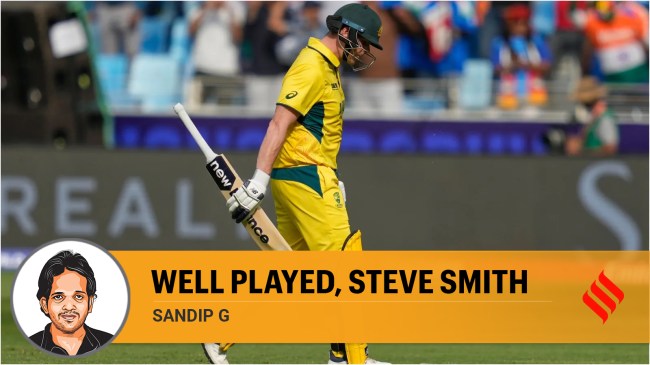Opinion Steve Smith, the role player and master
Maybe, Smith was too gifted for his own good. He could enact roles his teammates could not. He performed what Warner and Maxwell could, but neither could duplicate Smith
 Australia's captain Steve Smith walks off the field after losing his wicket during the ICC Champions Trophy semifinal cricket match between India and Australia. (credit: AP Photo)
Australia's captain Steve Smith walks off the field after losing his wicket during the ICC Champions Trophy semifinal cricket match between India and Australia. (credit: AP Photo) Some farewells are festivals. When paeans are penned on the departing legend, a river of tears is shed and statues erected. Some are merely mourned, for a career wasted, for a graph that never scaled its predestined peak, for the milestones left unachieved. Some are met with impassivity, with a sense of cosmic fatalism that everything that begins has to end. The emotions, or the lack thereof, that attended Steve Smith’s one day international adieu, swims in the third category. There was neither shock nor awe, but a chilling acceptance that it was inevitable in the broader scheme of stretching his Test career, where he is arguably the greatest batsman of his time.
The larger theme of his career remains strikingly similar in Tests and ODIs — a fascinating irony. He came as an outlier in Test cricket, with a bewilderingly unorthodox technique that was presumed to fall apart in tougher climes, that was not endowed to collect 10k runs and 36 hundreds, shimmering at the fifth spot in the all-time batting charts in red-ball cricket. The preconception when he burst forth — as a leg-spinner who could bat, well a little — was that his unconventional methods would weave seamlessly into the limited-overs fabric. But Smith has made an industry of making a mockery of suppositions, of bowlers, pundits and coaches. In neither format, though, was he touted to conquer greatness.
In ODIs, he became something of a semi-great. The body of work is impressive — 5,800 runs, 43.2 runs a game, a strike rate of 86.56, 12 hundreds, two-time World Cup champion. In another era, even a decade ago, these are numbers golden enough to grant access to the rarified space the regals of the game inhabited. But he played most of his cricket when the format itself was tussling with identity crisis, wondering whether it’s a crunched five-day game or an elongated T20 version. It faced the classic confusion of a middle sibling.
Smith’s plight was even more difficult, because his role was such that he had to bat in the past in a game that was leaping to the future. He embraced modernity, added deeper layers and gears into his batting, but with the phalanx of hitters around him, such as David Warner and Aaron Finch, Glenn Maxwell and Marcus Stoinis, he had to perform the anchoring duties for much of his career. He had the game to maraud — as he exhibited in his whirlwind hundreds against India in Sydney 2020 (105 off 66 balls, 104 off 64 balls).
Had Smith’s attacking inclinations remained unshackled by roles and responsibilities, his career could have been perceived differently. But a cricketer is often a product of his circumstances, of the team’s nature, specifications, and the strengths and weaknesses of his teammates. In a different milieu, Sachin Tendulkar would have never opened, or M S Dhoni redefined the art of finishing.
Maybe, Smith was too gifted for his own good. He could enact roles his teammates could not. He performed what Warner and Maxwell could, but neither could duplicate Smith. Even if they sometimes functioned in the Smith role, their range was not as vast as Smith’s. He had the unique gift, like the best, to make his fundamental game tick in every format. The contrast between Smith in Test and ODIs was not as vivid as day and night. In the limited-over versions, he would play some strokes more frequently than the others, pursue the aerial route more often and at times resort to the ramp and scoop. “I don’t play different formats differently. The batting is a reaction to the bowling, the required run rate, the conditions and fields,” he revealed in a cricket.com.au podcast.
He might not have been his white-ball teams’ most important batsman, but he has ferried Australia to monumental achievements. A big-match player, he shares the greatest number of 50-plus scores (5) in World Cup knockouts with Sachin Tendulkar. India would painfully remember the sparkling 105 off 93 balls he reeled out at Sydney in the 2015 semi-final clash. Only Ricky Ponting (442) and Martin Guptill (346) have mustered more runs than him (345) in the World Cup knockouts. Among those who have batted at No 3, only five have averaged better.
But the thread of paradox continues, because unless you go fishing for Smith’s greatness in ODI, you wouldn’t comprehend it. At the edge of his dishevelled blond mop, you wouldn’t spot the faint curves of a halo. He did not etch Smith moments in the game’s pages; he didn’t patent strokes. Even the twitches and shakes remained a novelty in Tests. The debates of function versus aesthetics he provoked, and his redefinition of beauty in batting, remain relevant to Test cricket.
Or, it could be that Smith, the Test cricketer, is so magnificent a spectacle that its radiance dims all other lights. It’s like the understated short stories or poems of a masterful novelist. As good as the short-form works could be, the novel makes his name. Smith the Test cricketer would be immortal, the white-ball less so. The pattern spills into his captaincy numbers. For one of the finest leaders of this century, the Sandpaper gate incident apart, his numbers in white-ball remain humble (a win percentage of 53 and no big titles to show).
Or it could be that Smith did not love the white-ball formats less, but he loves the longer format more, where his farewell could be a festival and not viewed with the detachment that has marked his goodbye from 50-over cricket.
sandip.g@expressindia.com




